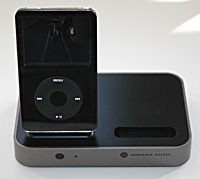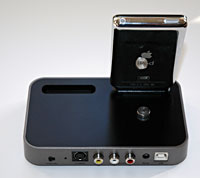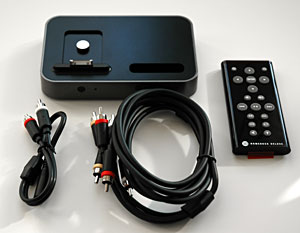|
|
|||||||
|
iPod Accessory Reviews: Digital Lifestyle Outfitters HomeDock Deluxe DLO HomeDock DeluxeEditor's rating (1-5): Review posted January 2007, by Jacob Spindel, Chief iPod Correspondent Editor's Note: check out our review of the updated HomeDock Deluxe. So you’ve hooked up your video- or photo-capable iPod to your television and impressed your friends by showing pictures and videos on TV. However, maybe then they will want to hear some of your hip audio-only music tracks, and suddenly you realize that, with a standard iPod-to-TV cable (with or without Apple’s Universal Dock), you can’t. As your friends start to head for the nearest exit, you start to wish that you could unify all your iPod-related video and audio needs with a single device. You might think that I’m talking about the forthcoming Apple product codenamed “iTV,” but it turns out that Apple has some serious competition already on the market. The HomeDock Deluxe from DLO is an impressive early entry in the race to make an iPod usable as an all-in-one entertainment center. Dock Shock Although it is indeed an iPod dock, the HomeDock Deluxe is not the standard “two speakers surrounding a docking bay” that you may be accustomed to. In fact, the unit itself has no speakers and no buttons. Instead, it is a rectangular base measuring just 5.8 x 3.8 x 1 inches, with a Dock connector on the left side. The connector is raised well enough to give you a decent chance of using the Dock without having to remove your favorite case, and it also includes a small plastic stand behind the Dock connector to prop up and support your iPod. DLO says the stand should work well for any model of iPod, and in my testing, it was effective with my 5G iPod 30 GB. The Dock is compatible with all varieties of the iPod mini, nano, 4G, and 5G lines, although if your iPod doesn’t support any photos or video files at all, then this is probably not the kind of dock you are looking for. The right side of the unit has a second “docking bay,” for the device’s remote control—although there is no actual electronic connection between the remote and the Dock, it is a clever way to decrease the chances of the remote getting lost.
The back of the HomeDock Deluxe has connectors for a standard USB cable and for the included AC adaptor, enabling you to sync and charge your iPod without removing it from the Dock. These are joined by the device’s two choices for output: a set of three standard composite (“RCA”) connectors, and an S-Video port. A set of composite cables is included, as well as a composite stereo-to-mono adaptor if your TV needs it. The only items on the front of the unit are the infrared remote sensor and the device’s name and logo.
What’s Up, Dock? The HomeDock Deluxe has two modes, which you toggle using a button on the remote: “iPod mode” and “On-screen display (OSD) mode.” In OSD mode, you are presented with a hierarchical series of menus, which you can use to navigate your music and playlists, very similarly to the iPod’s own interface, except that it is displayed on your television. Using the remote, you can locate the track you want and play it, and it will play with an on-screen, iPod-like progress bar (although it doesn’t support album art). |
Advertisement |
|
Apple’s own system of the Universal Dock and Apple Remote enables you to view pictures and videos, but you can’t play audio-only tracks. The HomeDock Deluxe bridges a major gap by adding this ability. However, for the media types that Apple does provide a TV interface for, Apple’s interface is the only option. Translation: OSD mode will not let you access pictures or video. DLO emphasizes in the device’s manual that, due to limitations in the iPod firmware, there is just no way around this. Although I don’t really have a way of checking the firmware to see if this is true, I will trust DLO and not count this limitation as a flaw in the HomeDock Deluxe, for the purposes of this review.
When you want to use pictures or video, you will need to toggle the Dock into iPod mode, making it virtually identical to a regular iPod video cable. You must navigate playlists and slideshows on the iPod’s own screen and then enable TV Out, and the pics and video will then show on the television screen. Nonetheless, DLO earns some major “bonus points” by making the remote truly useful for navigating playlists: You can scroll through playlists and move into and out of submenus using the remote, as well as providing volume controls. Although this may not sound very impressive, Apple’s own remote inexplicably lacks these capabilities, allowing you only to use play, pause, next, previous, fast forward, rewind, and volume when using the Apple Remote with the Universal Dock (even though the same remote has full navigation capabilities in FrontRow, which is essentially an iPod-style interface for your Mac). In short, I have no idea how anyone could read their iPod’s screen from across the room, but if you can do it, then you can fully navigate the menu hierarchy with the HomeDock Deluxe’s remote. The quality of the audio and video output depends almost entirely on the devices that you connect the Dock to (and the cables you use to do so), so I will not attempt to evaluate them in this review, although the quality level I perceived with my (admittedly modest) television setup was probably the best it could be with the TV I was using. |
Advertisement |
|
The Verdict For now at least, if you want to navigate and play back your audio files on a television, the DLO HomeDock Deluxe is the only game in town. Fortunately, the company’s attention to detail, with elegant features such as the useful remote, will not just make you say, “I like how the HomeDock does that,” but rather, “Why doesn’t everyone do that?” If the iTV ends up having the solution to the “dual-mode” problem hidden up its sleeve, then it might put some pressure on this product. However, very little is known about the iTV at this point, and, relative to products already on the market, the one that is currently the only choice is also a good choice. Pros: Enables iPod audio playback, in addition to the standard picture and video playback, on a television screen; remote is more functional than Apple’s own; charges and syncs iPods; compact, well-designed unit does a good job holding an iPod as well as the remote. Cons: None, except for the inconvenience of the two-mode system, which is probably not the device’s fault. Price: $149 Web Site: www.dlo.com Comparison Shopping: Where to Buy
|



